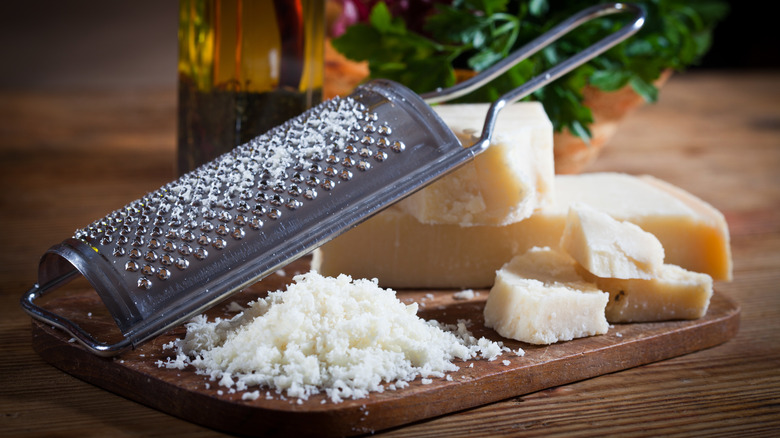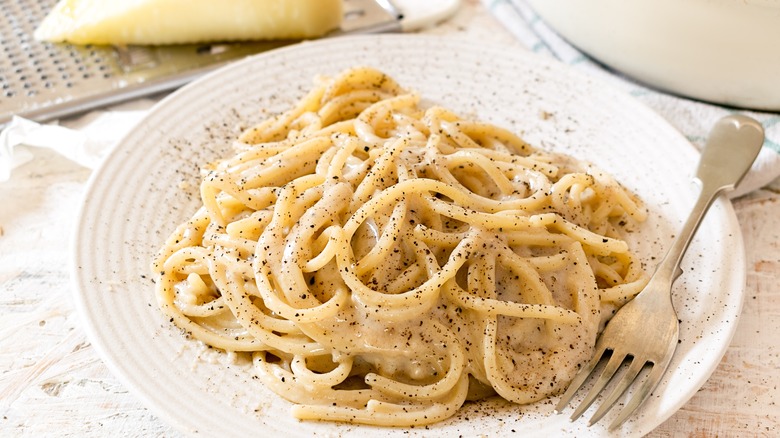Giada De Laurentiis' Stove Tip To Prevent Clumpy Cacio E Pepe
Cacio e pepe has been enjoying a long stay in the spotlight. People all over the world are learning to love the rustic simplicity of a creamy, sharp cheese sauce with plenty of black pepper, tossed with al dente noodles. But as simple the sauce appears — a basic version can require just three ingredients — it does take some skill to cook correctly. For example, if you carelessly add the signature pecorino romano right into the hot pan of pasta, you'll likely end up with large clumps of cheese instead of a silky sauce.
Italian-born chef and author Giada De Laurentiis knows exactly how to prevent this culinary catastrophe. On her TikTok account, the Food Network star shows her followers when and how to add the cheese to the shell-shaped pasta and other ingredients in her recipe.
@giadadelaurentiis #howto make Cacio e Pepe #pastatok #cacioepepe #ladolcevita #delicious #creamypasta #fyp #recipes
De Laurentiis takes her pan off the heat before sprinkling in the grated pecorino, then stirs the noodles thoroughly to create a smooth sauce. This allows the cheese to slowly melt into the dish, instead of being shocked by the heat and turning into a congealed brick or smaller clumps. Cacio e pepe is traditionally made with spaghetti or bucatini, but it's perfectly acceptable to use rigatoni, penne, or De Laurentii's choice of small shells. All of these more unconventional noodle shapes hold onto the creamy sauce well.
Why does cheese clump in the first place?
Cacio e pepe isn't the only recipe where clumpy cheese can ruin the end result. You may have experienced this disaster with homemade cheese sauce or fondue. The culprit usually comes down to too much heat. When it gets too hot, the protein in cheese coagulates and separates. The solids lose their liquid and fat and turn into a firm little blobs. Unless you're working with processed or American cheese, which contains salts and other additives to aid in gooey meltability, high heat can spoil the dish.
By turning the heat off before adding cheese to a pot or pan, your cooking vessel cool downs and creates a more gentle, evenly-heated environment, helping the cheese to break down slowly. This is especially important for hard cheeses that don't melt as well, due to their lack of moisture and/or fat. These include pecorino romano as well as parmesan, which Giada De Laurentiis adds to her cacio e pepe.
These cheeses can also clump when they're not grated finely enough, so grate your pecorino using the smallest holes on your box grater or the finest blade on your food processor. As you sprinkle the cheese into the pot, stir the pasta constantly. Don't stop mixing until you've achieved a silky consistency, and add some starchy pasta cooking water if your dish starts looking dry. This slow and steady technique should guide you to pasta success.
More tips for great cacio e pepe
A basic cacio e pepe is already delicious, but a perfect homemade version can rival one that you might enjoy in Rome. All it takes is some attention to detail. First, make sure your pasta cooking water is properly salted. This is your only opportunity to put flavor into the pasta itself, and the salty, starchy water left in the pot will both flavor and thicken the sauce.
Next, use freshly-cracked pepper, or grind peppercorns in a mortar and pestle. Pre-ground pepper is mostly flavorless and just won't do for this dish. Follow Giada De Laurentiis' lead and add the pepper to warmed butter or oil in a pan. Let it sit for a while, which toasts the spice and releases its flavorful oils. If you're not afraid to break tradition and want a boost of allium flavor, consider adding shallots to cacio e pepe by frying them with the pepper.
Once your pasta is done cooking, don't rinse it after draining! That would wash away the precious starches on the noodles that help to create a silky-smooth sauce. Finally, use authentic pecorino romano cheese from Italy. It is the only cheese that will create the authentic Roman flavor that makes this dish so beloved. If done properly, you'll have a pasta dish so creamy that it looks like heavy cream was involved, but really, your own care and finesse did all of the work. Talk about impressing your dinner guests.



